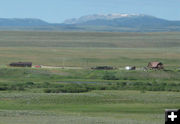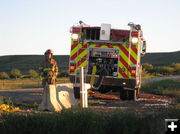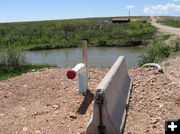

Burnt shop
Ranch from a distance after the fire. Burnt shop is in the center.
|


Fire Trucks
Fire Trucks from Daniel, Big Piney and Pinedale. The burnt shop is on left.
|


Firefighter James Bond
James Bond, of Daniel Fire Department, filling with water from the North Cottonwood dry hydrant during the fire.
|

"Dry hydrants are a great tool because we all know where the water sources are going to be, and they can be used year-round because they are placed where the water won’t freeze." - Big Piney/Marbleton Fire Chief John Ball.
Scroll down for more pictures.
|
|
Ryegrass Ranch Garage Fire
'Dry hydrants' help firefighters combat blaze
by Dawn Ballou, Pinedale Online!
July 17, 2010
Firefighters from Daniel, Big Piney and Pinedale responded to a blaze located on a rural ranch about twenty miles from Big Piney and Daniel. By the time firefighters arrived, the garage was fully engulfed in flames and, unfortunately, no firefighting efforts could save the building. It was determined that oil-soaked rags stored in a bucket had spontaneously combusted, causing the blaze.
This fire was a chance to utilize a new tool available to local firefighters in combating fires in rural areas. Over the past several years, the county has been strategically placing "dry hydrants" at carefully-selected locations where roads cross streams. The dry hydrant on North Cottonwood Creek allowed the firefighters to gain access to a nearby water supply, saving them valuable time refilling their water tender trucks instead of having to drive miles to access water further away.
A dry hydrant is a non-pressurized pipe system permanently installed next to a lake, pond, stream or cistern to provide a means of access to water, regardless of weather. In rural locations, firefighters often must shuttle water in from long distances in order to fight a fire, making it a challenge to have an uninterrupted supply of water at the scene. The purpose of a dry hydrant is to give firefighters ready access to an ample source of water during emergency situations. They are used to refill fire apparatus in order to continuously carry and supply large amounts of water to a fire scene that has no other source of water. "Dry" refers to the fact that they hydrant does not have a pressurized source of water like traditional fire hydrants. They are installed along the bank of a body of water, with the top of the access pipe extending above the ground and the bottom extending down into the water. The pump from the connecting vehicle draws strained water through the dry hydrant pipe into a tank on the truck.
Strategically located dry hydrants near developed water supplies allow access from a roadway instead of emergency vehicles having to work on soft ground adjacent to a pond or stream or setting up pump systems run by a generator, using long lengths of hose to get from the water to the refill vehicle. In the winter, when creeks are frozen over, the dry hydrants provide an access to the free-flowing water below the ice, giving firefighters a critical water supply to battle fires in rural locations.
Big Piney Fire Chief, John Ball explained why dry hydrants are a great tool to have. "We all know where the water sources are going to be, and they can be used year-round because they are placed where the water won’t freeze."
Seven dry hydrants have been installed by Sublette County, with at least seven more planned. The county Road & Bridge also uses the dry hydrants to access water for road maintenance. These are not used as a water source by private entities or the oil and gas industry.
The cost of installation and maintenance of a dry hydrant is very economical because there are no working parts in them, making them very attractive as another tool for rural fire departments for added fire protection. In some cases, the installation of dry hydrants can reduce insurance costs for area property owners.
Photos courtesy TJ Hunt, Sublette County Fire Warden
|


